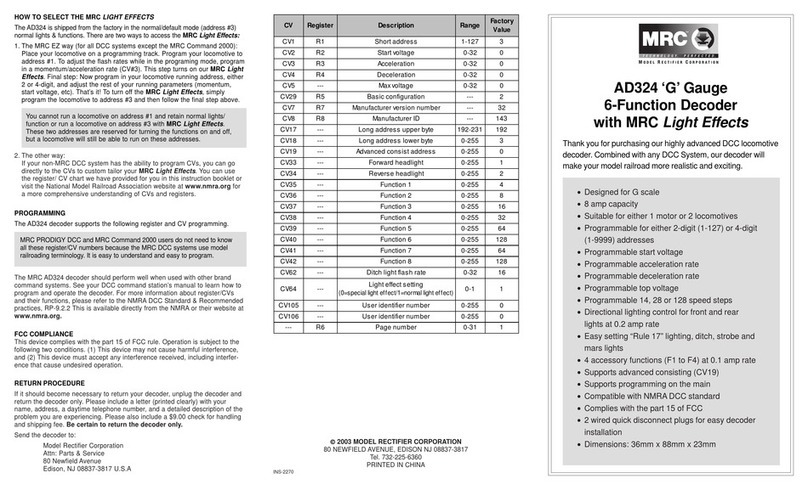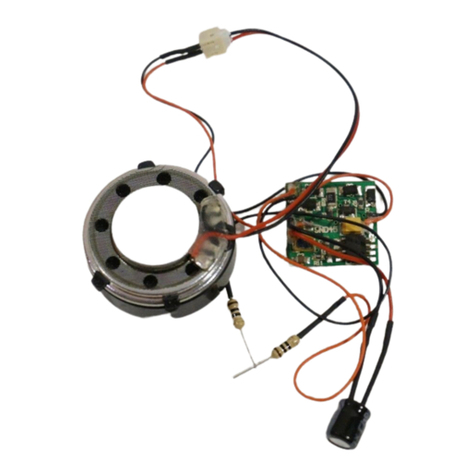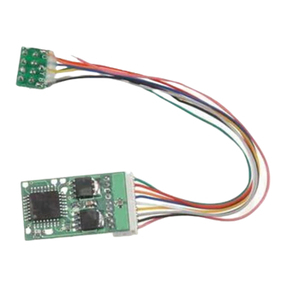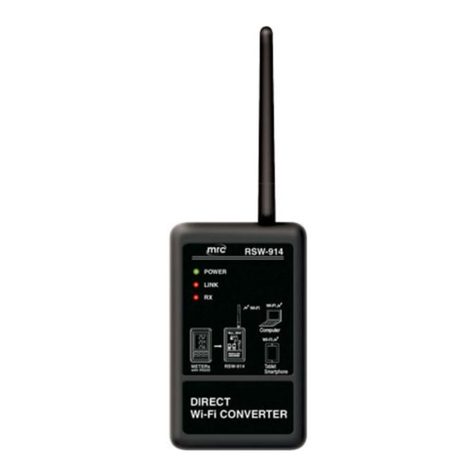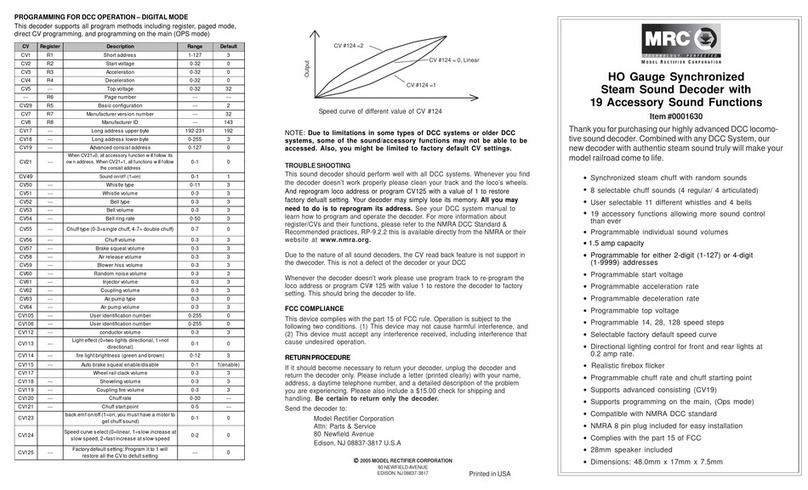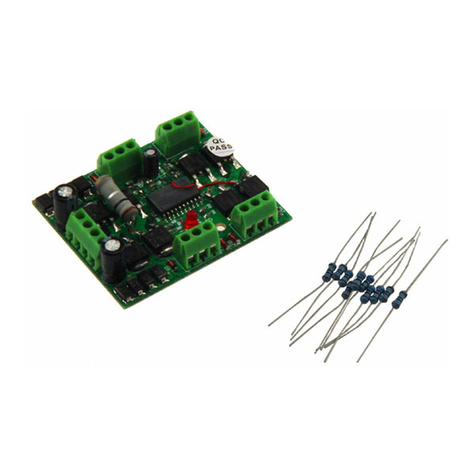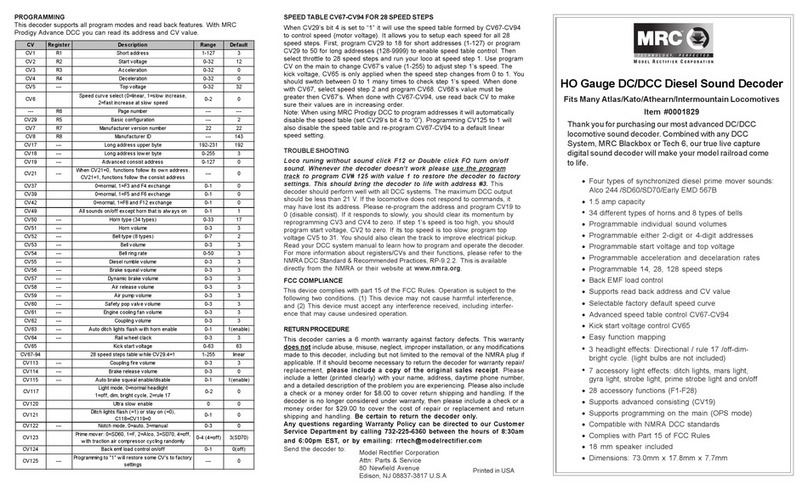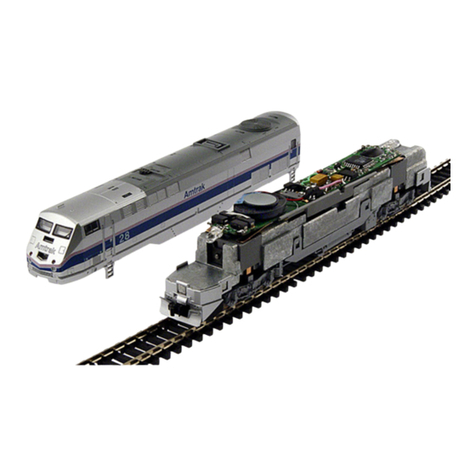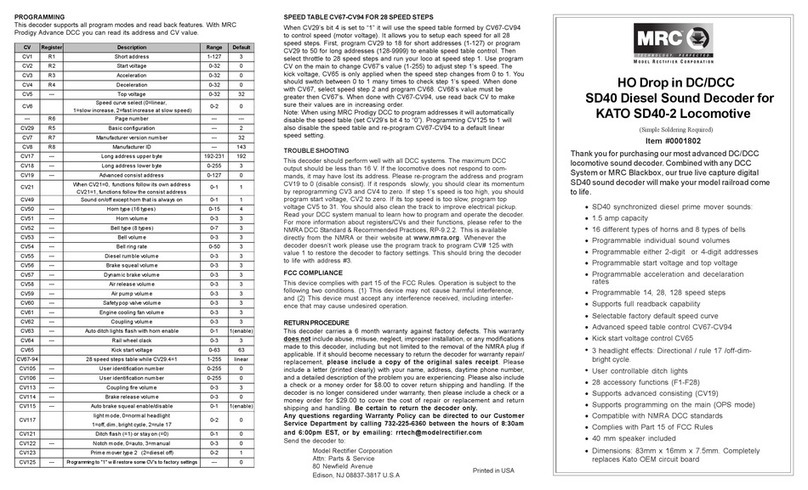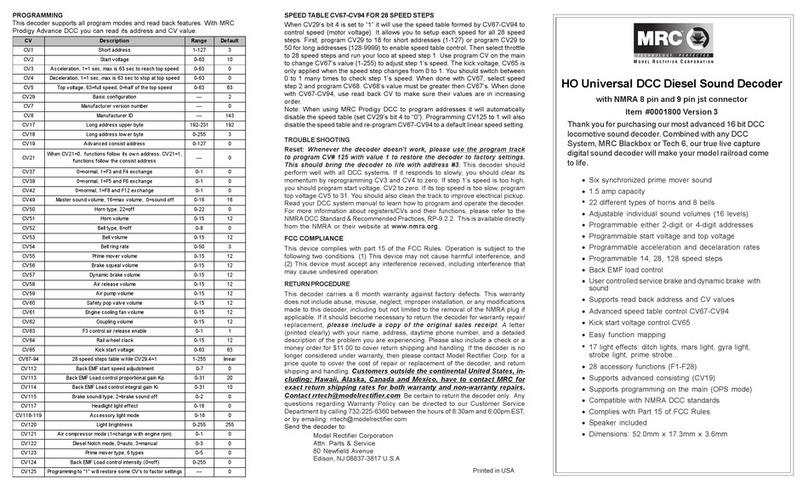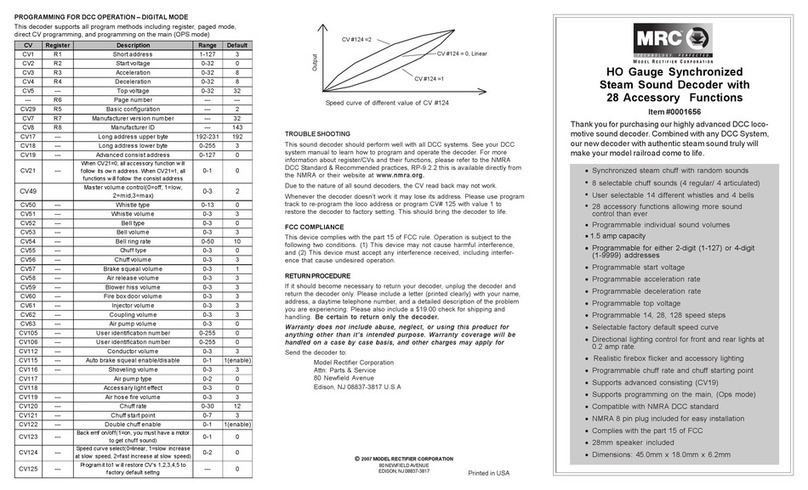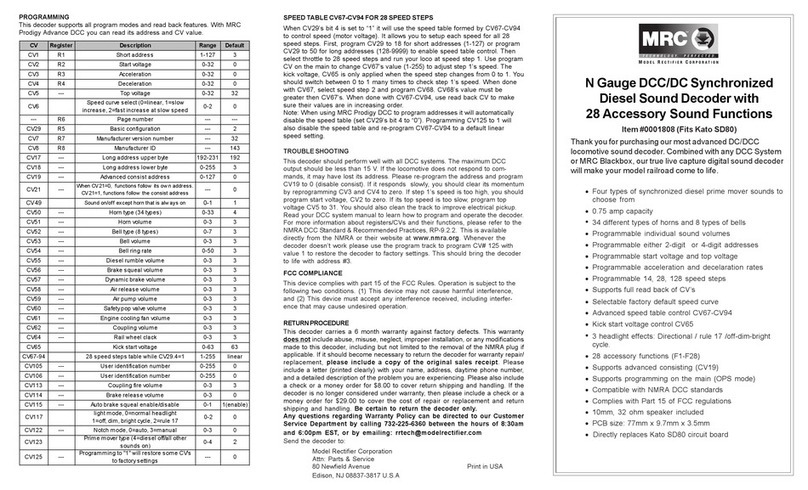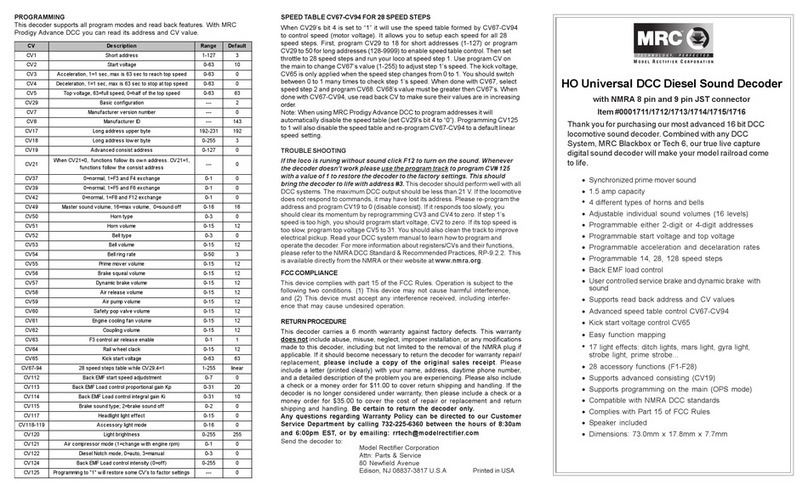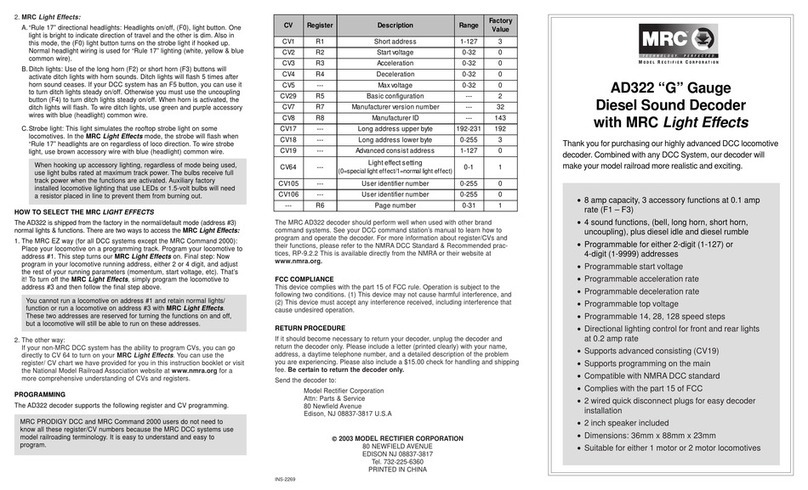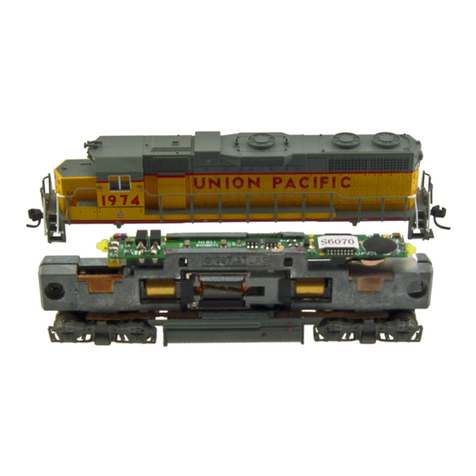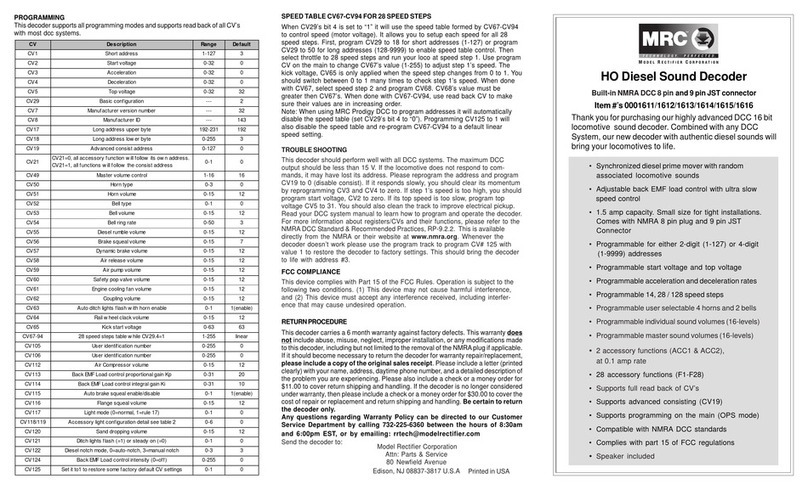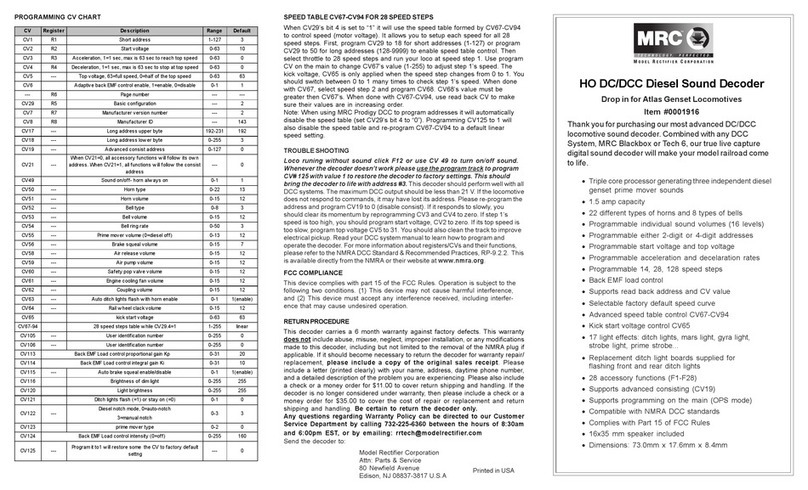
SPEED TABLE CV67-CV94 FOR 28 SPEED STEPS
When CV29’s bit 4 is set to “1” it will use the speed table formed by CV67-CV94 to
control speed (motor voltage). It allows you to setup each speed for all 28 speed
steps. First, program CV29 to 18 for short addresses (1-127) or program CV29 to 50
for long addresses (128-9999) to enable speed table control. Then select throttle to
28 speed steps and run your loco at speed step 1. Use program CV on the main to
change CV67’s value (1-255) to adjust step 1’s speed. The kick voltage, CV65 is
only applied when the speed step changes from 0 to 1. You should switch between
0 to 1 many times to check step 1’s speed. When done with CV67, select speed
step 2 and program CV68. CV68’s value must be greater then CV67’s. When done
with CV67-CV94, use read back CV to make sure their values are in increasing
order.
Note: When using MRC Prodigy DCC to program addresses it will automatically
disable the speed table (set CV29’s bit 4 to “0”). Programming CV125 to 1 will
also disable the speed table and re-program CV67-CV94 to a default linear
speed setting.
TROUBLESHOOTING
Whenever the decoder doesn’t work please use the program track to program
CV# 125 with value 1 to restore some cv’s to factory settings. This should bring
the decoder to life with address #3. You should also clean the track to improve
electrical pickup. Read your DCC system manual to learn how to program and
operate the decoder. For more information about registers/CVs and their
functions, please refer to the NMRA DCC Standard & Recommended Practices,
RP-9.2.2. This is available directly from the NMRA or their website at
www.nmra.org.
FCC COMPLIANCE
This device complies with part 15 of the FCC Rules. Operation is subject to the
following two conditions. (1) This device may not cause harmful interference,
and (2) This device must accept any interference received, including interfer-
ence that may cause undesired operation.
RETURNPROCEDURE
This decoder carries a 6 month warranty against factory defects. This warranty
does not include abuse, misuse, neglect, improper installation, or any
modifications made to this decoder, including but not limited to the removal of the
NMRA plug if applicable. If it should become necessary to return the decoder for
warranty repair/replacement, please include a copy of the original sales
receipt. Please include a letter (printed clearly) with your name, address,
daytime phone number, and a detailed description of the problem you are
experiencing. Please also include a check or a money order for $10.50 to cover
return shipping and handling. If the decoder is no longer considered under warranty,
then please include a check or a money order for $50.00 to cover the cost of repair
or replacement and return shipping and handling. Be certain to return the
decoder only. Any questions regarding Warranty Policy can be directed to
our Customer Service Department by calling 732-225-6360 between the hours
of 8:30am and 6:00pm EST, or by emailing: rrtech@modelrectifier.com
Send the decoder to:
Model Rectifier Corporation
Attn: Parts & Service
80 Newfield Avenue
Edison, NJ 08837-3817 U.S.A
CV Description Range Default
CV1 Shortaddress 1-127 3
CV2 Start voltage 0-32 0
CV3 Acceleration 0-32 0
CV4 Deceleration 0-32 0
CV5 Top voltage 0-32 32
CV6 Speed curve select(0=linear,1=slow increase atslow
speed, 2=fastincrease atslow speed) 0-2 0
CV29 Basic configuration --- 2
CV7 Manufacturer version number --- 2
CV8 Manufacturer ID --- 143
CV17 Long address upper byte 192-231 192
CV18 Long address lower byte 0-255 3
CV19 Advanced consistaddress 0-127 0
CV49 Master volume control 1-16 16
CV50 Horn type 0-22 13
CV51 Horn volume 0-15 12
CV52 Bell type 0-8 3
CV53 Bell volume 0-15 12
CV54 Bell ring rate 0-50 3
CV55 Diesel rumble volume 0-15 12
CV56 Brake squeal volume 0-15 7
CV58 Air release volume 0-15 12
CV59 Air pump volume 0-15 12
CV60 Safetypop valve volume 0-15 12
CV61 Engine cooling fan volume 0-15 12
CV62 Coupling volume 0-15 12
CV64 Rail wheel clack volume 0-15 12
CV65 kickstartvoltage 0-63 63
CV67-94 28 speed steps table while CV29.4=1 1-255 linear
CV105 User identification number 0-255 0
CV106 User identification number 0-255 0
CV112 Sand dropping volume 0-15 12
CV113 BackEMFLoad control proportinalgain Kp 0-31 20
CV114 BackEMFLoad control integral gain Ki 0-31 10
CV115 Auto brake squeal enable/disable 0-1 1(enable
CV116 Flange squeal volume 0-15 12
CV122 Diesel notch mode,0=auto-notch3=manual notch 0-3 3
CV123 prime mover type ( 2 types ) 3 or 4 3
CV124 Back EMFLoad control intensity(0=off) 0-255 160
CV125 Program it to1 will restore some CVto factory default setting 0-1 0
CV21 When CV21=0,all accessoryfunctions will follow its own
address.When CV21=1,all functions will follow the consist
address --- 0
2011 MODEL RECTIFIER CORPORATION
80NEWFIELDAVENUE
EDISON,NJ08837-3817 Printed in USA
HO DC/DCC Synchronized Diesel
Sound Decoder with 28 Accessory
Functions for Atlas S2/S4 Locomotive
Item #0001907
ThankyouforpurchasingourmostadvancedDC/DCCALCo
sounddecoder. Combined withanyDCCSystem or MRC
Tech6SoundController,ourtrue live capture digital ALCo
sound decoder will bring yourAtlas S2/S4 loco to life.
•Synchronizeddiesel prime mover withrandom
associatedlocomotivesounds
•Adjustable back EMF load control with ultra slow
speedcontrol
•1.5 amp capacity
•Programmablefor either 2-digit (1-127) or 4-digit(1-
9999)addresses
•Programmablestart voltage and top voltage
•Programmableacceleration and deceleration rate
•Programmable 14, 28/ 128 speed steps
•Directional lighting, (FO). Sunny White LED’s
included
•Programmable user selectable horns and bells
• Readback address and CV value
•28 accessory functions (F1-F28)
•Supportsadvanced consisting (CV19)
•Supports programming on the main (OPS mode)
•Compatiblewith NMRA DCC standards
•Complies with part 15 of FCC regulations
•Programmableindividualsoundvolumes
•18mm speaker included
PROGRAMMING
This decoder supports all program mode and read back feature. With MRC Prodigy
Advance DCC you can read its address and CV value.












